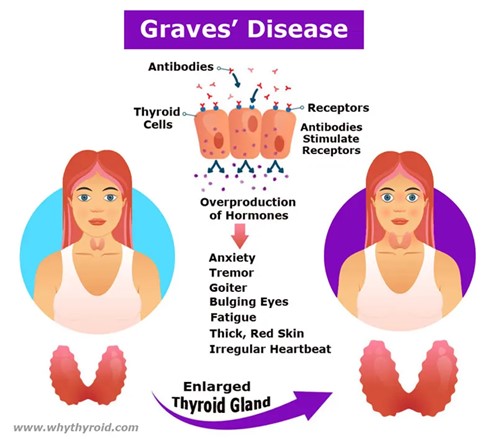A nurse is assessing an adolescent who has an exacerbation of Graves' disease (Hyperthyroidism). Which of the following findings should the nurse expect?
Heat intolerance
Weight gain
Bradycardia
Lethargy
The Correct Answer is A
A) Heat intolerance.
Explanation: This statement is true. Heat intolerance is a common symptom of hyperthyroidism, including Graves' disease. People with hyperthyroidism often have an overactive thyroid gland that produces an excessive amount of thyroid hormones. This can lead to an increased metabolic rate, which in turn makes them sensitive to heat. They may feel excessively warm, sweat more than usual, and have difficulty tolerating hot weather.
B) Weight gain.
Explanation: This statement is false. Weight gain is not a typical finding in Graves' disease or hyperthyroidism. In fact, one of the hallmark symptoms of hyperthyroidism is unexplained weight loss despite increased appetite. The elevated levels of thyroid hormones cause an increase in metabolism, leading to weight loss.
C) Bradycardia.
Explanation: This statement is false. Bradycardia refers to an abnormally slow heart rate, typically below 60 beats per minute. In hyperthyroidism, the heart rate is often elevated rather than slowed down. The excessive thyroid hormones can lead to an increased heart rate (tachycardia) and palpitations. It's important to note that if the question were about hypothyroidism (underactive thyroid), bradycardia might be more relevant.
D) Lethargy.
Explanation: This statement is false. Lethargy, or a state of extreme tiredness and lack of energy, is more commonly associated with hypothyroidism (underactive thyroid) rather than hyperthyroidism. Hyperthyroidism usually leads to symptoms of increased energy, restlessness, and hyperactivity due to the elevated metabolic rate caused by excess thyroid hormones.

Nursing Test Bank
Naxlex Comprehensive Predictor Exams
Related Questions
Correct Answer is A
Explanation
A. Replacement therapy may require daily subcutaneous injections.
Explanation: Growth hormone deficiency (hypopituitarism) often requires treatment with growth hormone therapy. One common method of administering growth hormone is through daily subcutaneous injections. Subcutaneous injections involve injecting the medication under the skin into the fatty tissue. This is a routine part of growth hormone therapy, and nursing considerations would include educating the child and their family about proper injection techniques, site rotation, and adherence to the treatment schedule.
Explanation for the other choices:
B. Lifelong replacement therapy will be required:
This statement is generally true. Growth hormone deficiency often requires long-term treatment, which may extend throughout childhood and adolescence. However, in some cases, the need for growth hormone therapy might change based on the individual's response to treatment and growth patterns.
C. Treatment is most successful if started during adolescence:
The optimal timing for starting growth hormone therapy can vary depending on the specific circumstances and the underlying cause of growth hormone deficiency. While treatment during adolescence can be effective, growth hormone therapy can also be successful if started earlier in childhood or later in adolescence. The key is identifying and treating the deficiency as soon as possible to promote healthy growth.
D. Treatment is considered successful if children attain full stature by adulthood:
While growth hormone therapy aims to support growth, achieving "full stature" might not always be possible. The goal of treatment is to help the child reach a more typical height based on their genetic potential and individual response to therapy. The success of treatment is determined by improvements in growth velocity and height, rather than necessarily achieving "full stature," which can vary greatly among individuals.
Correct Answer is B
Explanation
A) Document intake and output:
Documenting intake and output is an important nursing task, but it is not the top priority in a suspected case of bacterial meningitis. Timely administration of antibiotics to treat the infection takes precedence over documentation of intake and output.
B) Administer antibiotics when available.
Explanation:
Bacterial meningitis is a serious and potentially life-threatening infection of the membranes covering the brain and spinal cord. Rapid administration of antibiotics is crucial to effectively treat the infection and prevent its spread. Delay in antibiotic administration can lead to worsening symptoms and complications. Therefore, getting the appropriate antibiotics to the child as soon as they are available is the nurse's priority.
C) Reduce environmental stimuli:
Reducing environmental stimuli can be helpful in managing symptoms and providing comfort to the child with meningitis, but it is not the priority action. The immediate concern in a suspected case of bacterial meningitis is to treat the infection.
D) Maintain seizure precaution:
While maintaining seizure precautions is important, especially if the child has a history of seizures, it is not the top priority in a suspected case of bacterial meningitis. Administering antibiotics to treat the infection and prevent its progression is the primary concern.
Whether you are a student looking to ace your exams or a practicing nurse seeking to enhance your expertise , our nursing education contents will empower you with the confidence and competence to make a difference in the lives of patients and become a respected leader in the healthcare field.
Visit Naxlex, invest in your future and unlock endless possibilities with our unparalleled nursing education contents today
Report Wrong Answer on the Current Question
Do you disagree with the answer? If yes, what is your expected answer? Explain.
Kindly be descriptive with the issue you are facing.
